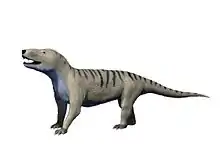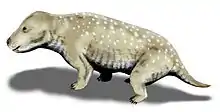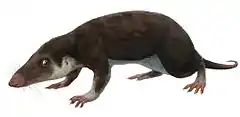Candelariodon
Candelariodon is an extinct genus of carnivorous cynodonts from the Middle Triassic Santa Maria Formation of the Paraná Basin in Rio Grande do Sul state, Brazil. Candelariodon is known from a partial mandible having some complete teeth. It was first named by Téo Veiga De Oliveira, Cesar Leandro Schultz, Marina Bento Soares and Carlos Nunes Rodrigues in 2011 and the type species is Candelariodon barberenai.[1]
| Candelariodon | |
|---|---|
 | |
| Holotype fossil of C. barberenai | |
| Scientific classification | |
| Kingdom: | Animalia |
| Phylum: | Chordata |
| Clade: | Therapsida |
| Clade: | Cynodontia |
| Genus: | †Candelariodon De Oliveira et al. 2011 |
| Species: | †C. barberenai |
| Binomial name | |
| †Candelariodon barberenai De Oliveira et al. 2011 | |
Description

The holotype (MMACR PV-0001-T) of Candelariodon barberenai comes from the Dinodontosaurus Assemblage Zone of the Pinheros-Chiniquá Sequence, Santa Maria Supersequence. It corresponds to the lower portion of the traditional Santa Maria Formation and the Santa Maria 1 Sequence of Zerfass et al. (2003). The outcrop that yielded MMACR PV-0001-T is located about 20 kilometres (12 mi) south of Candelária, Rio Grande do Sul, southeastern Brazil, in the Pinheiro, an area in which several tetrapods characteristic of the Dinodontosaurus Assemblage Zone have been discovered.[2]
References
- De Oliveira et al., 2011
- Martinelli et al., 2017, p.528
Bibliography
- Martinelli, Agustín G.; Marina Bento Soares; Téo Veiga De Oliveira; Pablo G. Rodrigues, and Cesar L. Schultz. 2017. The Triassic eucynodont Candelariodon barberenai revisited and the early diversity of stem prozostrodontians. Acta Palaeontologica Polonica 62. 527–542. Accessed 2019-03-25.
- De Oliveira, Téo Veiga; Cesar Leandro Schultz; Marina Bento Soares, and Carlos Nunes Rodrigues. 2011. A new carnivorous cynodont (Synapsida, Therapsida) from the Brazilian Middle Triassic (Santa Maria Formation): Candelariodon barberenai gen. et sp. nov.. Zootaxa 3027. 19–28. Accessed 2019-03-26.








